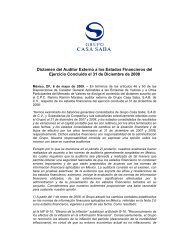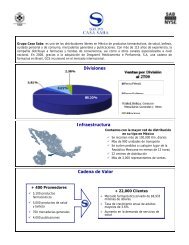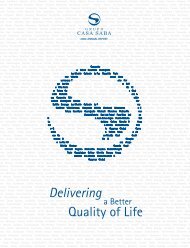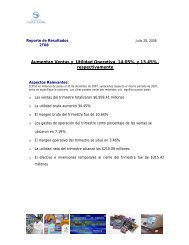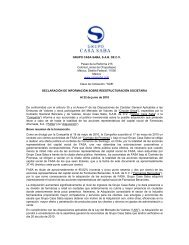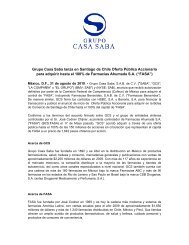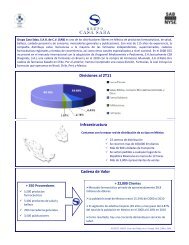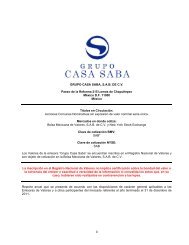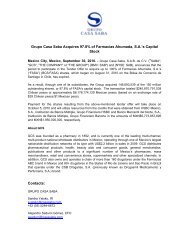FORM 20-F Grupo Casa Saba, S.A.B. de C.V.
FORM 20-F Grupo Casa Saba, S.A.B. de C.V.
FORM 20-F Grupo Casa Saba, S.A.B. de C.V.
You also want an ePaper? Increase the reach of your titles
YUMPU automatically turns print PDFs into web optimized ePapers that Google loves.
Table of Contents<br />
(4) To calculate U.S. dollar amounts, IMS Health used the annual average based on the daily interbank rate published by OANDA Corporation (based on data from Banco Central<br />
<strong>de</strong> Chile, the Chilean Central Bank). The U.S. Dollar rate used for conversion in <strong>20</strong>11 was CLP 483.01 per U.S.$1.00.<br />
In Chile, national laboratories represent around 57% of the total market and international laboratories the remaining 43%. Together, they sell approximately 70% of<br />
their product lines through the retail pharmacy segment while the remaining 30% is sold to both Private and Public Institutions as well as directly to physicians and individual patients.<br />
Unlike Mexico and Brazil, the Chilean retail pharmacy market is a highly consolidated and, therefore, a highly competitive market with three main drugstore chains<br />
making up approximately 90% of the playing field. As a result, our primary competitors are the other two major chains: Salco-Brand and Cruz Ver<strong>de</strong>.<br />
In general, our retail pharmacies compete on the basis of store location and convenient access, customer service, product selection and price. We believe continued<br />
consolidation of the drugstore industry in Mexico and Brazil, the aggressive discounting of generic drugs by supermarkets, specialized generic drug pharmacies and mass<br />
merchandisers and the increase of promotional incentives to drive prescription sales will further increase competitive pressures in the retail pharmacy market of the countries.<br />
Seasonality<br />
Both our distribution and retail business are subject to seasonal fluctuations and related market conditions. For example, during the winter months (which is from<br />
November – February in Mexico and May – August in Chile), we stock additional cold and flu care products to meet the seasonal <strong>de</strong>mand for these items. During the warmer months,<br />
the population tends to consume larger quantities of alimentary tract aids and antibiotic products and, on the front end, we feature personal care items such as sun tan lotions and<br />
<strong>de</strong>o<strong>de</strong>rants. Allergy season also requires us to supply greater quantities of these remedies.<br />
Socio-economic factors also dictate spending patterns linked to specific seasons. The back-to-school period means that the average household incurs higher out-ofpocket<br />
expenditures, leaving them less disponsible income to spend elsewhere. In December, employeers are required to give their employees a holiday bonus, so disposable income is<br />
typically higher at the end of the year.<br />
During vacation periods such as Holy Week (March – April <strong>de</strong>pending on the Easter break) and summer break, children are less likely to contract illnesses from their<br />
fellow schoolmates and there is also generally less traffic in the points-of-sale.<br />
Our cash flows are also subject to seasonal fluctuations and market conditions. To maintain a larger winter inventory and to ensure a<strong>de</strong>quate inventory levels for the<br />
two or more weeks of holidays in December, during which suppliers in Mexico and Chile do not make sales or <strong>de</strong>liveries, our accounts payable and inventories typically increase at yearend<br />
for both our distribution and Mexican retail divisions. After reaching their highest levels in November/December our inventories gradually <strong>de</strong>crease to what we estimate is a normal<br />
operational level of approximately 50 inventory days. See “Item 5. Operating and Financial Review and Prospects—Liquidity and Capital Resources—Overview”.<br />
50



